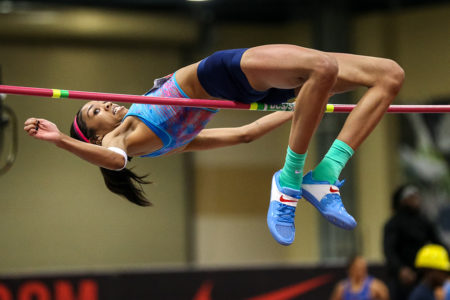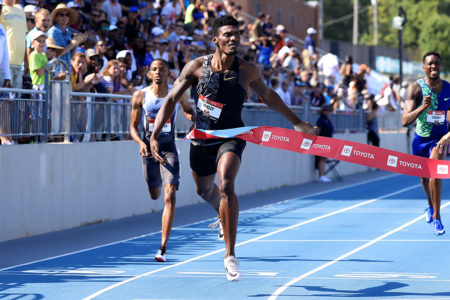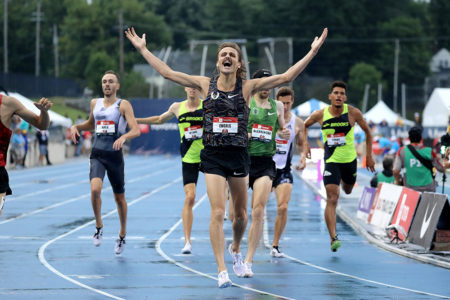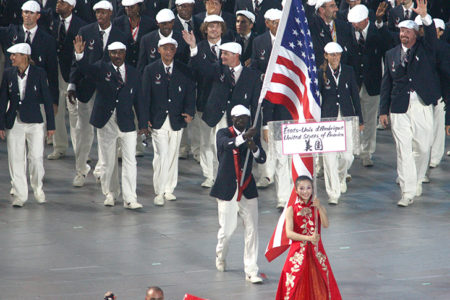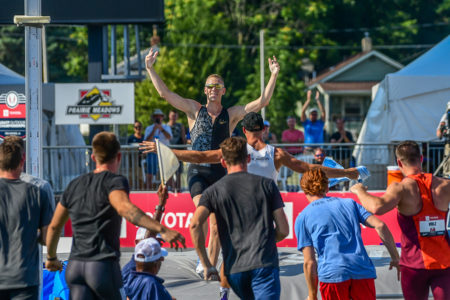Here’s this month’s collection of generally off-track activities that have gone a long way towards shaping the way the sport is headed

New Indoor Venue Coming In Oregon?
Next year Eugene will be boasting the finest track & field facility in the nation. At a late-July gathering to bring people up to date on next year’s big Olympic Trials (ticket sales “already at record pace,” said TrackTown CEO Michael Reilly) the mayor of neighboring Springfield made a major announcement, saying that her city of some 60,000 was moving ahead with plans for a state-of-the-art indoor facility that would feature a hydraulically banked oval. “I’m very excited because it’s meant to complement Hayward Field and just add to the track & field legacy that is truly this region’s legacy that nobody else in the world has,” Lundberg said. “I’m more than happy to promote that as much as possible. We want cranes up by the spring of 2021.”
Germany’s Big Combo Nationals A Success
Would you believe a paid monster crowd of 34,350 for the final day of the German Track & Field Championships (after 26,200 the first day)? What kind of brilliant marketing scheme put that many butts in seats? Credit “Die Finals Berlin 2019” in which the German capital coordinated with the national governing bodies of 10 sports and a pair of TV broadcasters to stage a 6-day affair that served as the national championships in each of them. Overall, the affair drew some 178,000 spectators, with some of the “minor sports” being staged for free.
The Sports Examiner posed the question, “Could this be done in the U.S.? The program in Berlin was promoted for a full year, was on national television (and streaming) live and had each of the 10 national federations running their own programs that were marketed under a common umbrella. The U.S. Olympic Committee tried analogous events [think Olympic Sports Festival] in the past and failed. But not multiple national championships and in fact, the USOPC would not need to be involved at all. The U.S. National Governing Bodies could do this on their own. Will they? Will a U.S. city step up? Can the Olympic Movement in the U.S. afford to miss an opportunity like this?”
A Steal For A Mere $437,500
To say that vintage shoe collectors are a brand apart would be an understatement. As correspondent Mark Cullen explains in his blog trackerati.com, a world record was set in July: “Shoe impresario Jordan Geller, already the dominant force in the collecting of vintage Nike shoes, etched his name into the history books—and, once again, the Guinness Book of World Records—with his sale of a pair of rare 1972 Moon Shoes for the staggering sum of $437,500. The shoes, designed by Bill Bowerman and handmade by Nike’s third employee, Geoff Hollister, were made for the 1972 US Olympic Marathon Trials, but never worn.” The sale was part of an offering by noted auction house Sotheby’s called the “Ultimate Sneaker Collection.” The first 99 pairs were bought by Canadian entrepreneur Miles Nadal for $850,000. Nadal subsequently then paid the staggering amount for the Moon Shoes, of which only about a dozen pairs were ever made, with this pair the only ones in unworn condition. Eat your heart out, Jimmy Choo!
Vaulter Chris Nilsen Votes No On Going Pro
It has become close to SOP these days that if a collegiate athlete shows any kind of international promise before their senior year going-pro-early is almost expected. That protocol hasn’t swallowed up South Dakota star Chris Nilsen, who obviously had all kinds of enticements to vault for bucks after winning his second straight NCAA title (beating one Mondo Duplantis in the process), but instead decided to return for his senior year with the Coyotes. “At the time when I considered [turning pro], it was almost like a flash-in-the-pan sort of thing,” he told the Mitchell Daily Republic. “It didn’t feel like it was the right decision to do right now. I can definitely jump higher in college. I can do it next year and make sure I have my degree coming out of college.” He continued, “Pole vault is fun and I enjoy doing it, but it’s kind of up and down financially. Also getting to compete with USD for another year because they’ve done so much for me. Just repaying them by doing all four of my years and hopefully coming back as an assistant coach would be great.”
Good News For The OT Marathons
U.S. 26-milers were thrown a bit of a curveball back in March when the IAAF announced very tight ’20 Olympic qualifying standards. How tight? The men’s number was pegged at 2:11:30 (compared to 2:19:00 for Rio) and the women’s at 2:29:30 (compared to 2:45:00). This was all part of the international governing body’s move to have its world rankings determine about half the entrants (in all events). Those marks would have been pretty tough for American marathoners to achieve in a hilly part of Georgia at over 1000ft of altitude, potentially rendering the OT results as not particularly meaningful. But in late July Monaco’s cavalry road to the rescue, signing off on USATF’s request to have the races assigned “Gold Label” status. In the IAAF’s road-racing world, that means that anybody who finishes in the top 5 of such a race is assumed to have the Tokyo standard, no matter what their time. Bottom line: the top 3 in each race should have a spot on the team.
NCAA Champ Hoppel Goes Pro Early
“After a brief period of determining how to move forward in my career, I have decided to forgo my senior year of collegiate eligibility and pursue my dream of running professionally,” Bryce Hoppel said in a statement posted on the Kansas website 2 days after he made the 800 team for the World Championships. “I would like to thank everyone who has helped me get to this point in my life. My ability and accomplishments would not have been possible if it were not for the people who surround me and show me an unimaginable amount of love and support.”
He subsequently told the Midland Reporter-Telegram, “I was coming close [to graduating]. I think that was one of the things that kind of pushed me toward (going pro) as well. I should finish up in this next year without too heavy of classes. I think that was the best move. Just everything at Kansas is just kind of working for me, they just have been a great support system. I couldn’t be more happy that I chose to come here because even now they are just helping me through the whole process.”
Things Heating Up In Tokyo
It’s always something as an Olympics draws near. A year out from Tokyo, weather and traffic concerns dominate the headlines about the XXXII Summer Games. On July 24—exactly a year before Opening—officials staged a traffic test, closing key exits and entrances to the freeways and shortening the duration of green lights in an attempt to simulate heightened traffic flow. Reportedly, traffic flowed “more smoothly” than usual, according to Kyodo News, though jams popped up in other spots.
The heat remains the biggest concern. Daily highs this summer have ranged from 86 to 95 degrees (31-35C), with attendant high humidity readings. Organizers are already planning a wide range of strategies to protect athletes and fans from the heat, however, after a rowing test event in early August where three competitors fell to heat exhaustion, some officials said that more needs to be done.
One thing that organizers needn’t be worried about: filling seats. Local demand for tickets is 10 times the supply. Scarcity of tickets will be the real challenge for visitors.
For an Olympics where the local sponsorship has already exceeded a cool $3 billion—more than three times more than any other Olympics—it paints a rosy picture of the financial solvency of the ’20 Games.
Russia has taken exception to Japan’s interactive online map of the Torch Relay, even mentioning the possibility of a boycott. The map shows the South Kuril Islands as Japanese territory. The islands were seized by the Soviets in the waning days of WW II, and the two nations have never resolved the dispute or signed a peace treaty. □
